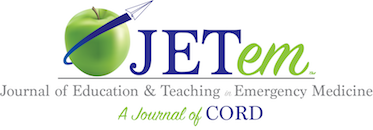Novel Asynchronous Emergency Medicine Sub-Internship Curriculum Utilizing Free Open Access Medical Education (FOAM)
ABSTRACT:
Audience and Type of Curriculum:
This emergency medicine asynchronous curriculum is designed for emergency medicine sub-interns.
Length of Curriculum:
The curriculum runs monthly over a four-week sub-internship rotation.
Introduction:
Emergency medicine sub-interns are at an intermediate stage of training and require exposure to material that agrees with their training level. Asynchronous learning is an effective way to supplement sub-interns’ learning, and free open-access medical education (FOAM) provides valuable content for asynchronous curricula.
Educational Goals:
The global purpose of the curriculum is to supplement sub-interns’ learning with high-yield emergency medicine topics while introducing them to various FOAM resources.
Educational Methods:
A gap-analysis was conducted to suggest content most appropriate for the asynchronous curriculum, and the curriculum was designed with adult learning theories in mind. The educational strategies used in the curriculum include articles, videos, podcasts, diagrams, cases, and practice questions from various high-quality FOAM resources. The content is broken up into four core modules (trauma, eye complaints, shock, obstetric and gynecologic (OBGYN) complaints) and two bonus modules (orthopedic complaints, ultrasound basics), and the modules are available on the sub-internship website for students to access throughout their rotation.
Research Methods:
The educational content was evaluated by the learners using pre-rotation, post-module, and post-rotation surveys.
Results:
Survey results show that at least 95% of students agreed with meeting each of the modules’ learning objectives. The curriculum also significantly increased learners’ confidence in evaluating specific chief complaints and ultrasounds. Students reported an increased likelihood of changing their clinical practice, an increased awareness of the role of social determinants of health, and an increased preparedness for residency after engaging with the curriculum.
Discussion:
Asynchronous curricula using thoughtfully-selected FOAM content and resources can effectively supplement synchronous learning methods in emergency medicine sub-internships. The curriculum is easy to implement and receives high satisfaction from students.
Topics:
Sub-Internship, asynchronous curriculum, free-open access medical education, trauma, eye complaints, shock, OBGYN complaints, ultrasound, social determinants of health.
